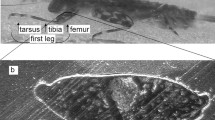Summary
We tested whether larval black flies actively control the positioning of their feeding appendages (labral fans), and if so, whether their posture represents a balance between the conflicting demands of drag and feeding. We compared the postures of live larvae with the postures of larvae killed by heat-shock in three different flow regimes in a laboratory experiment; we assumed that the postures of heat-killed larvae approximated a passive response to drag. The average height of the labral fans above the bed declined significantly in faster flows, and was significantly greater in live than dead larvae. There was also a significant interaction effect, since the difference between the fan heights of live and dead larvae was greater in slower flows. Two mechanisms may contribute to this result. Larvae in slower flows have to increase their fan heights more than larvae living in faster flows to achieve comparable increases in velocity and thus particle flux. In addition, muscular strength may limit the feeding postures larvae can assume. The fan heights of live larvae also varied depending on the concentration of food particles: larvae exposed to low food concentrations held their fans higher above the bed than did larvae exposed to high food concentrations in the same flow regime. This change in posture is due neither to an uneven particle concentration in the boundary layer nor to added drag from particles trapped in the labral fans. Collectively, our results indicate that these suspension feeders actively control their feeding posture, and suggest that these varying postures represent a dynamic balance between the conflicting needs of minimizing drag and maximizing feeding.
Similar content being viewed by others
References
Barr WB (1984) Prolegs and attachment of Simulium vittatum (sibling IS-7) (Diptera: Simuliidae) larvae. Can J Zool 62:1355–1362
Braimah SA (1987) The influence of water velocity on particle capture by the labral fans of larvae of Simulium bivittatum Malloch (Diptera: Simuliidae) and Isonychia campestris McDunnough (Ephemeroptera: Oligoneuridae). Can J Zool 65:2395–2399
Chance MM, Craig DA (1986) Hydrodynamics and behaviour of Simuliidae larvae (Diptera). Can J Zool 64:1295–1309
Currie DC, Craig DA (1987) Feeding strategies of larval black flies. In: Kim KC, Merritt RW (eds) Black flies — ecology, population management, and annotated world list. Penn State Univ Press, University Park, pp 155–170
Denny MW (1988) Biology and the mechanics of the wave-swept environment. Princeton University Press, Princeton, New Jersey
Dixon WJ (1988) BMDP statistical software manual. Univ. California Press, Berkeley
Eymann M (1988) Drag on single larvae of the black fly Simulium vittatum (Diptera: Simuliidae) in a thin, growing boundary layer. J N Am Benthol Soc 7:109–116
Everest FH (1967) Midget Bentzel current speed tube for ecological investigations. Limnol Oceanogr 12:179–180
Hart DD (1987) Processes and patterns of competition in larval black flies. In: Kim KC, Merritt RW (eds) Black flies — ecology, population management, and annotated world list. Penn State Univ Press, University Park, pp 109–128
Hart DD, Latta SC (1986) Determinants of ingestion rates in filter-feeding larval black flies (Diptera: Simuliidae). Freshwat Biol 16:1–12
Hurlbert SH (1984) Pseudoreplication and the design of ecological field experiments. Ecol Monogr 54:187–211
Jumars PA, Nowell ARM (1984) Fluid and sediment dynamic effects on marine benthic community structure. Am Zool 24:45–55
Koehl MAR (1977) Effects of sea anemones on the flow forces they encounter. J Exp Biol 69:87–105
Koehl MAR (1984) How do benthic organisms withstand moving water? Am Zool 24:57–70
Kurtak DC (1973) Observations on filter feeding by the larvae of black flies (Diptera: Simuliidae). PhD dissertation, Cornell University, Ithaca, New York
Merz RA (1984) An experimental field study of the role of flow on feeding behavior, tube structure, and cluster morphology of the sabellid polychaete Eudistylia vancouveri. PhD dissertation, University of Chicago, Chicago, Illinois
Muschenheim DK (1987) The dynamics of near-bed seston flux and suspension-feeding benthos. J Mar Res 45:473–496
Nowell ARM, Jumars PA (1984) Flow environments of aquatic benthos. Ann Rev Ecol Syst 15:303–328
Palumbi S (1984) Tactics of acclimation: morphological changes of sponges in an unpredictable environment. Science 225:1478–1480
Sih A (1980) Optimal behavior: can foragers balance two conflicting demands? Science 210:1041–1043
Snedecor GW, Cochran WG (1980) Statistical methods. Seventh edition. Iowa State University Press, Ames, Iowa
Statzner B, Gore JA, Resh VH (1988) Hydraulic stream ecology: observed patterns and potential applications. J N Am Benthol Soc 7:307–360
Vogel S (1981) Life in Moving Fluids. Princeton University Press, Princeton, New Jersey
Wetzel RG (1983) Limnology. Second edition. Saunders College Publishing, Philadelphia, Pennsylvania
Author information
Authors and Affiliations
Rights and permissions
About this article
Cite this article
Hart, D.D., Merz, R.A., Genovese, S.J. et al. Feeding postures of suspension-feeding larval black flies: the conflicting demands of drag and food acquisition. Oecologia 85, 457–463 (1991). https://doi.org/10.1007/BF00323756
Received:
Accepted:
Issue Date:
DOI: https://doi.org/10.1007/BF00323756




